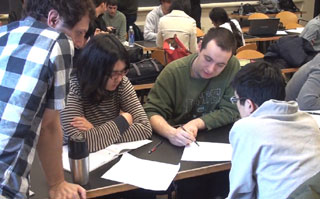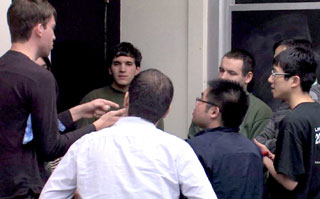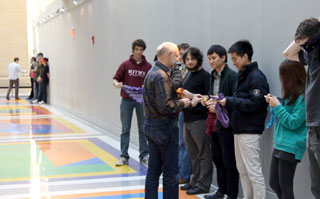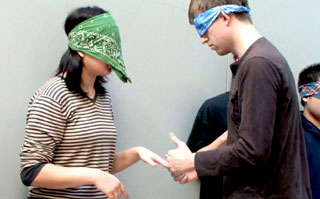In this section, Prof. Haynes Miller and Susan Ruff describe the team-based nature of the course as well as a workshop designed to guide students toward successful collaboration.
Mathematicians often collaborate with each other, so the course is structured to give students a taste of not only research, but also research collaboration.
The 27 students are grouped into nine teams that stay together throughout the semester. The various strategies that have been used to create student teams are further described on the Forming Teams page.
Each team works differently. Often, each student takes on a different part of the work. For example, one student may develop a theory for addressing the problem in one dimension while another creates a computer simulation to explore the problem in two dimensions. The students typically work on their own for several days and then come together to compare notes. We are in favor of this collaboration strategy, since it mimics successful collaboration of professional mathematicians.

A team of students working together on mathematical exploration of their research topic. (Image courtesy of MIT OpenCourseWare.)
Value of Teamwork
Judging from student survey responses at the end of each semester, many students value the teamwork aspect. In good situations, students can do more as a team than they would be able to as individuals. They can help each other, learn from each other, try a wide range of approaches, and draw upon complementary skills and interests to overcome hurdles. They can motivate each other and bounce ideas off of each other. When it comes to writing, authors are often too close to their own writing to see problems, so teammates can give each other valuable feedback.
Teamwork can be challenging! We actually hope that students wrestle somewhat with teamwork, make conscious decisions about how to address their issues, and through that process become better prepared for future teamwork. We monitor the teams’ dynamics during the weekly meetings, which allows us to gauge whether everyone is contributing equally and whether students are giving each other fair credit. However, when conflict arises, each situation is different and calls for a different resolution. When absolutely necessary, we have broken a team apart.
From a logistical standpoint, having the students work in teams is necessary to meet time and staffing constraints. On average, mentoring the research and writing of nine student groups requires almost 40 hours per week. Supporting 27 individual students would simply not be feasible. From the student perspective, working in a group enables the team to produce satisfying results in the short time available for each project.

After being divided into teams, students discuss strategy briefly before the actual activity. (Image courtesy of MIT OpenCourseWare.)
Teamwork Workshop
To help students communicate well in their teams and address conflicts professionally, Susan typically leads a teamwork workshop on the first or second day of class. This workshop has developed over the years, and we are pretty happy with its current form.
The workshop begins with an icebreaker activity, in which students have a set amount of time to strategize for and complete a team challenge in groups of nine students. For this challenge, we ask the students to tackle a task that would be simple under ordinary conditions, but is not so easy when the students place bandanas over their eyes and are not supposed to speak with one another.
This activity is fun and starts the class on a good note. We alert the students to use the activity time to start thinking about past experiences in teams, so the activity also prepares them for the subsequent class discussion on teamwork.

Prof. Haynes Miller hands out materials for the students to use in the challenge. (Image courtesy of MIT OpenCourseWare.)
The most important part of the teamwork workshop is the discussion. During the discussion, which usually lasts about 25 minutes, we ask students to answer the following questions based on the teamwork activity and on their past experiences in teams.
- What makes a team work well?
- What makes a team fail?
- What can you do to improve the chances that teams you are on work well?
The discussion is driven primarily by the students: when a student describes a possible teamwork issue, the other students are asked to suggest strategies for avoiding or addressing the issue. When a strategy is suggested, the class is asked to vote on whether they agree with the strategy and, if they disagree, to suggest alternatives. We use this structure because a main goal of the discussion is to convey the idea that different people have different teamwork styles—for example, some prefer to have a team leader while others prefer a more collaborative style—so it is important for each team to discuss teamwork expectations. Another goal of the class discussion is to expose students to a variety of strategies for handling common teamwork issues. The students often have remarkably good ideas for how to facilitate effective teamwork, but we suggest strategies as well. Some strategies are detailed below.

Each team employs a variety of strategies, such as making hand signals and using sounds as indications. (Image courtesy of MIT OpenCourseWare.)
Effective Communication
Effective communication is essential for effective teamwork. We encourage students to have regular meetings because communication is often easier in person; facial expressions and tone of voice are helpful in understanding what someone is saying.
We also encourage students to interact outside of team meetings. If multiple teammates enjoy jogging, for example, they could go jogging together. Such informal interactions provide teammates with opportunities to have conversations about the project that they would not have at an official team meeting, and those informal, spontaneous conversations can yield unexpected insights.
We also talk about cultural differences in communication. For example, a common communication difference that we point out is the turn-taking pause. In conversation, how long of a pause signals that the speaker is done speaking? In some cultures it is acceptable for a second person to start speaking while the first person is still saying words, while in other cultures the words are expected to be followed by a long pause. If the second person speaks too soon, they are considered to have interrupted. Having a teammate with different turn-taking expectations can be incredibly frustrating, so we suggest some strategies: if a student has a teammate who rarely speaks, we encourage the student to ask the silent teammate questions and to leave longer pauses. Similarly, if a student has a teammate who seems to continually interrupt, we encourage the student to try to adjust his own turn-taking pauses to match. In both cases, explicitly acknowledging the differences in communication culture, and the frustration they cause, can enable both teammates to adapt.
Finally, to ensure effective communication, we encourage students to think carefully about what their teammates are saying and check that they understand by asking follow-up questions.
When to Raise an Issue
Not everything needs to be communicated. A useful model for considering when and how to address a conflict was given by Blake and Mouton in 1970 (“The Fifth Achievement,” Journal of Applied Behavioral Science, 6, 413–426). Essentially, the choice of strategy can depend both on the importance of the outcome and on the importance of the relationship, as illustrated by the following table. The main point is that not every conflict must be addressed.
| The relationship is important to me. | The relationship is not important to me. | |
| The outcome of the conflict is important to me. | Directly address the issue and collaborate to find a solution. | Exert power to try to achieve the desired outcome. |
| The outcome of the conflict is not important to me. | Try to smooth things over. | Withdraw from the conflict. |
Conflict Resolution
When teamwork issues need to be addressed directly, a useful strategy comes from conflict resolution. We suggest that students phrase problems as being about themselves rather than about their teammates. For example, instead of saying, “You always finish your work at the last minute,” a student could say, “It takes me quite a while to read a paper, and I can’t stay awake in my classes if I go to sleep past midnight. Could we swap our sections by 7 p.m., so that I can review yours before I have to go to bed?”
Balancing Work Load
When one student does not seem to be contributing, we encourage students to consider whether there is an issue that they are unaware of that is preventing their teammate from contributing. Other teammates can try to ask questions and offer up chances to the student to contribute his or her ideas. Sometimes it is helpful to address such issues during a meeting with the project mentor, who can facilitate the conversation as an impartial third party.
Focus on the Goal
Whenever there are teamwork issues, perhaps the most helpful strategy is to focus on the team’s goal: the project. The math is challenging and the research is fun, so focusing on the goal can often make the teamwork issue seem less important.
Advice from Past Students
Past students have offered some helpful advice:
- “You do not have to like your teammates to succeed as a team. Stay respectful and professional.”
- “You are a team, and team members should help each other out. Stress of any sort can affect team dynamics, but be aware that if someone is being rude to you, there may be other factors that are contributing to that. Because you are working in teams, you implicitly have permission to be straightforward with each other and say, ‘You know, I have to say it and I’m uncomfortable about saying it, but I will anyway.’”
- “Be kind to your teammates. Answer email, even if only to say you got it and you will reply later.”










